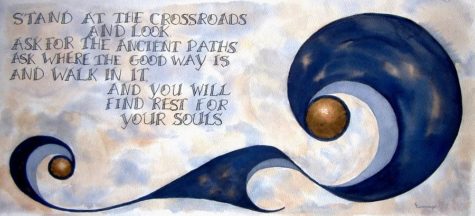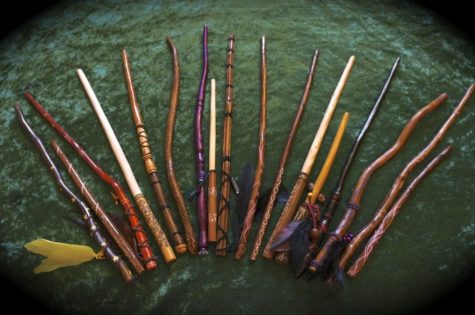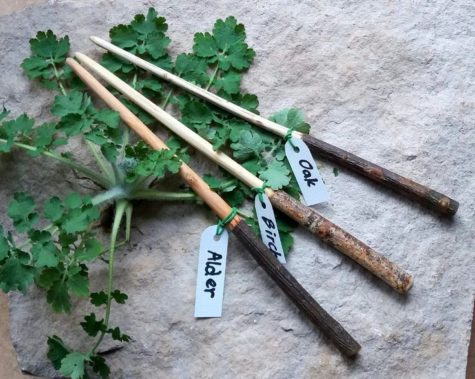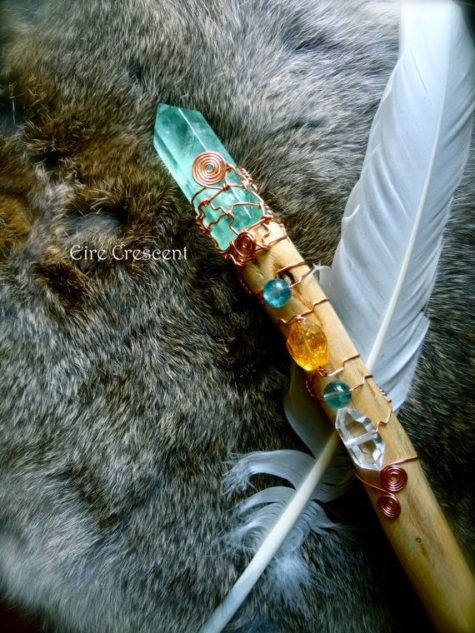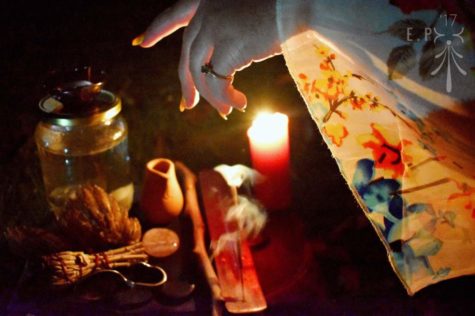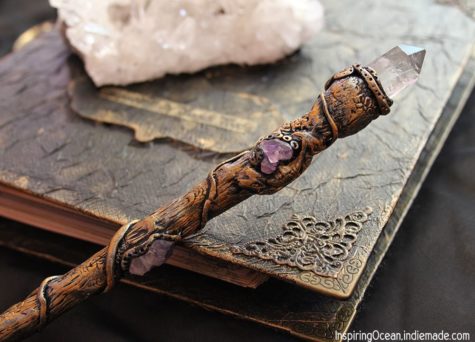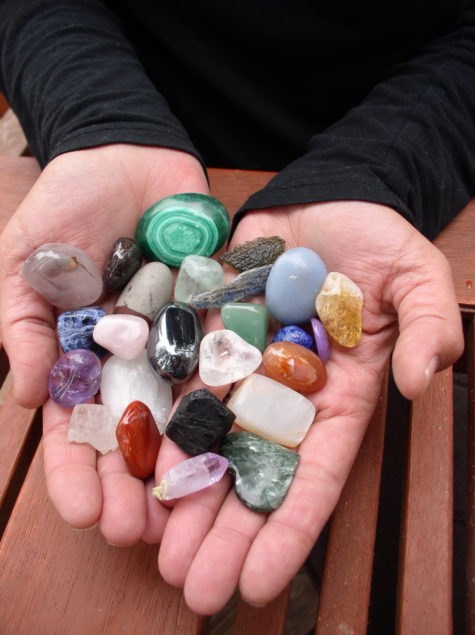Monthly Archives: May 2019
Crossroads are considered sacred in almost all magical traditions. A crossroads is a universally accepted place to hold rituals, leave offerings, or dispose of items you wish to be rid of.
To relieve feelings of depression, helplessness, and hopelessness, journey to a crossroads and absorb the power.
The crossroads is the juncture of powerful energies, where all possibilities meet. Don’t go to a traffic intersection – the most common modern crossroads. Excessive yang energy will only worsen the situation. What you need is a traditional witch’s crossroads, ideally the intersection of remote streets but at least roads with minimal traffic.
You don’t have to do anything; just linger, keep your mind open and absorb the converging energies.
About Crossroads:
It is believed that Hecate rules over the three-way crossroads. She can see the past, present, and future. It is said that if you should approach a three-way crossroads at night, you would hear her black dogs howling. Her altars have been erected at such places for centuries.
The four-way crossroads are considered to be powerful because all four directions meet at one point. Dirt, rocks, and sticks gathered from such a crossroads are said to have powerful spiritual connections, albeit tricky ones to master. In Greek myths, Oedipus met his fate at the crossroads. From the Yoruban people we have Legba (a god known for his clever tricks) ruling the crossroads.
The strength of Ellegua lies at the crossroad. He is the remover of obstacles. An offering of twenty-one pennies and three candies left at the crossroad will prompt him to be kind and remove the roadblocks in your life.
Ancient people were afraid of what it meant when one direction met another direction. All manner of folklore is available concerning the crossroads. Fairies are said to hang out there, along with ghouls, ghosts, and goblins. Even the Christian Satan is said to roam the crossroads.
Times Square in New York City is known as the “Crossroads of the World.” A true urban crossroads is any intersection where 3 or 4 roads mead and then continue outward unobstructed for eight city blocks in each direction. If any one path is blocked by a dead end, a cul de sac, or a park, it is not a true crossroad.
Metaphysically, a crossroads is a place of sacred transformations, a metaphor for transformational points in our lives, and relate to time and choices. It is a place to go to unblock your path.
Why Crossroads Are So Important
In ancient times the crossroads were places where very important information was exchanged, information that might never reach a town or village. To facilitate this, a common language developed. Called a lingua franca, such a language permitted people from different countries to understand each other well enough to do business.
In addition to learning a common language like lingua franca (Latin was the lingua franca of educated people in Europe for many centuries), crossroads experiences invariably stimulate a desire to learn a foreign language.
Did you know that learning a foreign language increases your intelligence? One reason is that it builds bridges of communication between the right and left side of the brain, increasing flexibility. A person who can come at a problem with right and left brain flexibility has double the resources of someone relying on just one or the other. In addition, on the one side, you learn to speak another language but on the other side, you develop the telepathic ability to understand someone else’s language. This ability often transcends the words being spoken and heard as many people with language ability will tell you.
Important information is exchanged at crossroads. Here is an example of some of the kinds of important information that might have been exchanged at a crossroad.
- Be careful, it is no longer safe to drink the water at xx
- Be careful the king of xx is dying and the country is run by renegades who no longer honor our trade agreements
- Warning, there was a spring flood which washed away the trail at xx
- Good news! The mountain pass is clear now.
- Good news! The king of xx wants trade in his country and has cleared the bandits out of the gulch at xx.
- The price of amber has dropped. Don’t be fooled into paying high prices.
- The market for silk has shifted further west … be careful not to buy more than you can sell.
- Xx’s supply of xx is terrible this year. Best go in another direction with what you have to sell.
People who stay at home in the town and village don’t need this kind of information. But if they are wise, they listen to news from travelers because it can portend things in the future. For example a traveler returns and says, “I have been to xx and they will pay fabulous sums of money for this yellow stuff that washes up on the beaches around here [amber]”. Or he might say, “There are restless tribes marauding close to here. We need to be careful or they will wipe us out.” There is no way for a connection to be made between towns and villages if someone doesn’t travel.
In addition to Hekate, Elegua, and various other deities, Mercury, the god of travel, communication, and thieves, presided over the crossroads. The Greeks erected little phallic statues (no pun intended) honoring the god Mercury along the side of the road and at crossroads to honor the god of travelers.
Sources:
Magick Wands are magickal tools that have two main functions.
- To Focus Energy
When a magick wand is properly crafted and enchanted it creates an energy focusing tool. When a wand has energy channeled into it the wand will focus the energy into a beam that comes out of its tip.
- To Empower The User To Do Magick
The most basic magickal reason for a wand is that when picked up it tells the wizard now is the time to do magick. Magick, or as we like to call it manifestation creates largely based on our thoughts. If you magickally created every thought you had, we would have problems. A Magick Wand solves this problem by allowing wizards to think about anything without their thoughts affecting the world around them (by not holding their wand).
Think of it as a wizard has a “Magickal Wizard” powered up state, to activate this state he must be holding his wand. When in this powered up state any magick or spells he casts will be more powerful than they would be without his magick wand.
Many spells can be channeled through a wand, to those who do not understand magick this may seem like the wand itself is casting the spell. But the spell itself is being cast by the user, not the magick wand tool itself.
How To Make A Wand
One of the first home-made tools of any Witch is the wand, as it is usually relatively simple.
Most Witches would agree that a wand should be made from wood, preferably fallen not cut. First, find the tree your wood will come from; remember you want it to give you something of itself for your magickal work, so take it an offering of some kind by way of introducing yourself. Once you have done this, look all around the tree to see if there is already something suitable on the ground. If there is not, come back at a later date. you may need to repeat this several times.
The piece you are looking for should be straight, about as thick as your thumb, and the length of the area between your elbow and your palm. Once you have something which seems likely, thank the tree, and then take it home to dry. It usually takes around 6 weeks of gentle drying before the wood is ready for working.
Whilst you are waiting look several times at your wood and decide if it lends itself to any particular shaping and if you want to remove any bark. When it is ready, shape it and remove the bark if you wish. Using sandpaper smooth down both ends and the length too if you wish. Start with a coarse paper and move down to the finest you can get. Then decorate it in the way you prefer and polish it with beeswax. It is now ready to be consecrated.
Favored Woods For Wand Making
“People are like trees,
it takes time to grow a good one.”
Good woods for wand making include Oak, Ash, Rowan, Willow, and Hazel. Here’s a list of woods associated with different magickal traditions:
- Ainu: Bamboo, with leaves remaining. Top carved into spiral designs
- Berber: Oleander
- Celtic: Hawthorn, hazel
- China: Peach, willow
- Druid (British): Hawthorn, rowan, yew
- Druid (Gaul): Oak
- Romany: Elm
- Russian: Slavic birch
- Scythian: Willow
Lightning-struck wood is considered packed with power. Driftwood makes an excellent wand; it does not have to be cut and combines the powers of Earth and sea.
Keep in mind that no wood will work as well for you as the wood from a tree with which you have forged an alliance.
Wands are not limited to wood. Metal wands are excellent power conductors. Embellish with crystals, seashells and charms. Copper is a particularly excellent conductor of energy. An iron wand provides power and protection.
Wands For Special Purposes
- For Love and Seduction: Copper topped with rose quartz.
- Lunar Wand: Place a moonstone atop a silver wand, for moon, love, and fertility magick.
- Mermaid’s Wand: Driftwood topped with coral, pearls, or shells for lunar, love, fertility, and money. magick as well as rituals by the sea.
- Highly protective ritual wand: Wrap copper wire around an iron wand, embellish with hematite and black tourmalines.
- Empowered Wand: A quartz crystal tip empowers any all-purpose wand.
- For Romance and Love: A rose quartz attached to the wand enhances romantic spells, as do carved symbols for love such as heart or rose.
- Spiritual Quests and Cleansings: Top or embellish with Amethyst crystals.
- Added Protection: Black tourmalines, Herkimer diamonds, and smoky quartz used to embellish a wand provide added protection during ritual use.
Wrap your wand in leather, red silk or other magickal fabric when not in use. Store it in a box for safety if you like, however, wrap it in cloth first.
For optimum power, keep your wand beside you as much as possible to absorb your energy and desires, and harmonize your vibrational energies. Many sleep with their wands either beside them in bed, or beneath them.
Consecrating Your Wand
Consecration is a magickal act, which call upon the spirits of the world to bless your tool, and to dedicate it to a particular purpose. Once a tool has been consecrated it is empowered to do magick by the powers of tree and land, by you heart and by your hand.
The act of consecration is an important step in the process that marks the shift from the creation phase to the active use of the tool. This is not to say that you may no longer embellish your magickal tools after they have been consecrated, but they should be completed to a level that they are ready for use.
- Preparations for Consecration:
Choose a time and date; if possible work with the dark moon. This is a time of beginning, potential energy and intention setting. Give yourself plenty of time. You may want to take a cleansing bath or shower, or purify yourself with tree resin incense such as Frankincense, Myrrh, Copal, or Dragon’s Blood.
You will want to “set the stage” for this small personal ritual. It is best performed outdoors in a quiet place, or a quiet space in your home. You may also do the consecration at the the tree from which you harvested the wood.
- Assemble the things you will need:
The things you need will include incense, a candle, water and soil or salt. These represent the elements and will help you to connect with universal essence and bring your blessing into balance.
You will also need the wand to be consecrated in a carrying bag, a candle in a wind proof container (if you are doing the consecration outside), a lighter, a containers for the water and salt, , a bell or bells, an alter cloth, and anything else you are inspired to bring.
If you are doing the consecration indoors, soft, healing music will help you to relax and focus.
You may also want to choose a beautiful piece of cloth to keep your wand wrapped in when you are not using it. This cloth will be blessed as part of your Wand dedication. Many people favor a cloth made of all natural materials, others choose their cloth by colors, pattern and energy they feel when looking at the cloth, both are fine. Whichever you choose, it should be heavy enough to provide a snug place for your Wand to nestle.
- The Dedication
When you arrive, take some time to set up your portable alter with the four elements in their appropriate directions, and your tools.
Once you have set up, take a few moments to tune into the space. Get quiet. Listen to nature outside and inside. Find your center. Hear your heartbeat and your breath rhythms. When you are ready, start with a simple invocation.
“Dear Goddess and God, spirits of this land, spirit of the trees, spirit of (whatever tree your wand is from), and spirit within, I ask for your presence, your blessings, and your protection on the ritual of consecration”.
Pause to sense the arrival of the sacred. Now take your wand into your hands and speak the following as you consecrate it:
“In the name of Lady Gaia and the Forest Lord, I consecrate this wand with the wisdom of Air”
Run the wand through the smoke from the incense completely from end to end.
“The strength of fire”
Run the wand over or quickly thru the candle flame.
“The love of water”
Sprinkle water over the wand.
“The endurance of earth”
Sprinkle wand with earth or salt.
“And the enchantment of the Faery realms.”
Ring bells over wand.
Pick up wand and and hold it to your heart.
“I dedicate this wand to be a sacred instrument of my power and will. May it serve the deepest and highest good of myself and all beings. By earth, by flame, by wind, by sea. As I will so mote it be. With gratitude to the Lord and Lady, to the forest and the trees, spirits of this place and all witches, I now complete this consecration ritual. Blessed be.”
Wrap up your tools and alter with care. Now that your wand is consecrated you will want to keep it safe and contained when not in use. Some witches do not allow others to handle their tools once consecrated so that the tool stays clear and connected to only you. This is up to you.
The more you work with your Wand, the more comfortable you will be with each other. Whenever you work with your Wand, you will want to create a sacred space. The way you setup for your Wand dedication is also a good way to setup for working with your Wand. Adding other items to your sacred space is fine. Popular items many people add are: seashells, leaves, pentacle, crystals, rocks, Athame, Goddess or God statues
More About Wands
A wand is a thin, straight, hand-held stick of wood, stone, ivory, or metal. Generally, in modern language, wands are ceremonial and/or have associations with magick but there have been other uses, all stemming from the original meaning as a synonym of rod and virge, both of which had a similar development.
In ecclesiastical and formal government ceremonial, special officials may carry a wand of office or staff of office representing their power. Compare in this context the function of the ceremonial mace, the sceptre, and the staff of office. This is a practice of long standing; in Ancient Egypt, priests were depicted with rods. Its age may be even greater, as Stone Age cave paintings show figures holding sticks, which may be symbolic representations of their power.
From the collection of the Brooklyn Museum.In Pharaonic Egypt, toilette articles, weapons against possible enemies, amulets against serpents, were also left in the tomb, together with magick texts and a magick wand which enabled the ka (soul) to use them.
In classical Greco-Roman mythology, the god Hermes/Mercury has a special wand called a caduceus.
Six- to eight-foot-long staves with metal tips adorning them are carried traditionally in Freemasonry during rituals of the Craft. Ceremonial uses may have several wands for different purposes, such as the Fire Wand and the Lotus Wand in the Hermetic Order of the Golden Dawn. In Zoroastrianism, there is a similar ritual implement called a barsom.
In Wicca and Ceremonial magick, practitioners use several magickal tools including wands for the channeling of energy—they serve a similar purpose to the athame although the two have their distinct uses. While an athame is generally used to command, a wand is seen as more gentle and is used to invite or encourage. Though traditionally made of wood, they can also consist of metal or crystal. Practitioners usually prune a branch from an Oak, Hazel, or other tree, or may even buy wood from a hardware store, and then carve it and add decorations to personalize it; however, one can also purchase ready-made wands.
In Wicca the wand usually represents the element air, or sometimes fire, although contemporary wand makers also create wands for the elements of earth and water as well. The wand is most often used by modern Pagans, witches, Shamans and others in rituals, healing and spell casting.
There is some scholarly opinion that the magick wand may have its roots as a symbol of the phallus. It may also have originated as the drumming stick of a shaman, especially in Central Asia and Siberia, as when using it to bang on his drum or point, to perform religious, healing, and magickal ceremonies.
Sources:
- ALEXANDRITE is a rare and expensive gemstone, when worn it draws luck and good fortune.
- AMBER is the fossilized resin of ancient coniferous trees.It has been used for nearly every purpose in magic. Warm to the touch, it is thought to possess life. Lucky and protective.
- APACHE TEAR, a globule of translucent obsidian, is carried as a good-luck charm.
- AVENTURINE is an all-around luck stone.
- CHALCEDONY, an arrowhead carved of chalcedony is worn or carried for luck.
- CHRYSOPRASE is a lucky stone worn for eloquence, success in new undertakings, and to attract friends.
- COPPER is a lucky metal, perhaps because of its past solar attributions, and so can be used in combination with any luck-bringing gemstones.
- CROSS STONE, a form of andalusite is found in coarse crystals. When broken open or sliced, they display a symmetrical cross pattern of alternating dark and light colors. As with all stones exhibiting unusual shapes or patterns, it is carried for luck.
- L-SHAPED stones are thought to bring good fortune, perhaps because this form suggest the conjunction of the spiritual with the physical. They can be carried as good luck pieces or placed on the altar.
- LEPIDOLITE is a purplish type of mica rich in lithium. It is a beautiful yet fragile mineral, carried to attract good luck to it’s bearer.
- LODESTONE is carried in pairs — one to protect and the other to bring good luck.
- OPAL, due to its flashing colors and beautiful unique appearance, the opal is a luck-bringing stone. The modern idea that the opal is a stone of misfortune, sorrow, and bad luck is untrue and can be traced back to a reference in the novel, Anne of Gierstein by Sir Walter Scott.
- ORANGE stones have some of the fire of red but are gentler in their effects. Protective, they have often been seen as symbols of the Sun and are thought to be luck attracting.
- SARDONYX was at one time engraved with an eagle’s head, set in silver, platinum, or gold, and worn to bring good luck.
- TIN is carried as a good-luck piece and can be shaped into talismans to attract money.
- TURQUOISE like all blue stones, is lucky and is carried to attract good fortune.
From: Cunningham’s Encyclopedia of Crystal, Gem and Metal Magic

